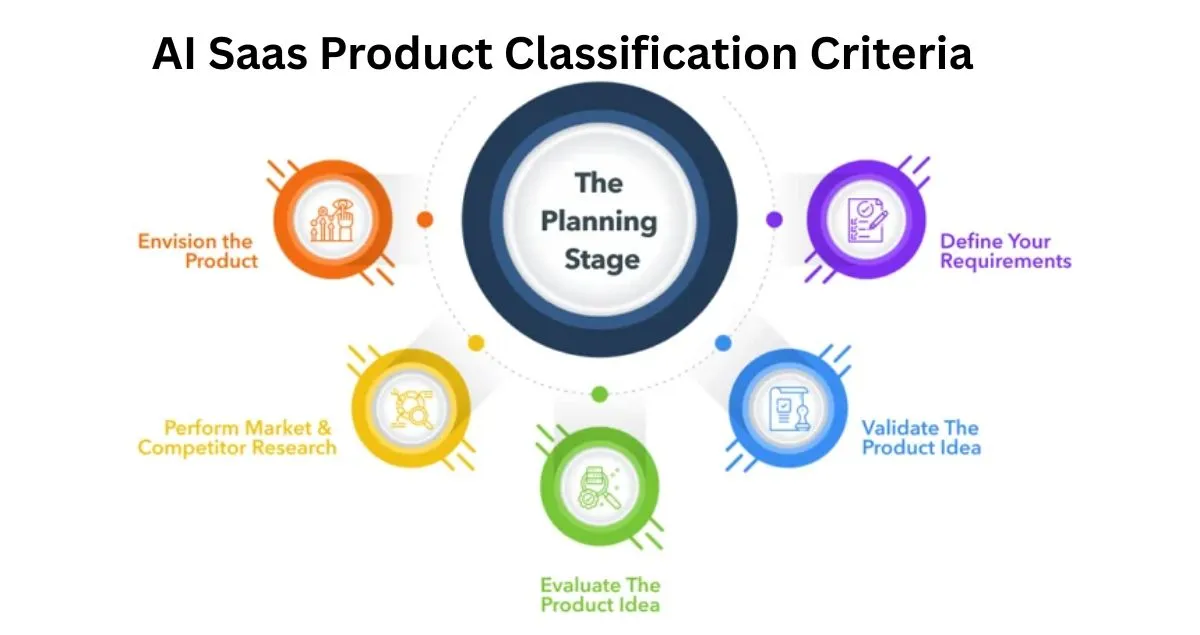Artificial intelligence has transformed how SaaS (Software as a Service) products are built, sold, and used. But as the market grows, so does the confusion around how to evaluate and compare these products. This is where AI SaaS product classification criteria come in.
Whether you are a buyer, developer, investor, or founder, understanding how these tools are categorized helps make smarter decisions. Let’s explore what sets one AI-powered SaaS product apart from another—and how classification works in the real world.
AI SaaS Product Classification Table (2025 Overview)
| Classification Factor | Criteria Description | Why It Matters |
| Core AI Functionality | Predictive, generative, analytic, or decision-based | Defines the main purpose of the AI |
| Industry Use Case | Finance, Healthcare, Retail, HR, Marketing, etc. | Aligns product with user needs |
| Deployment Model | Cloud-based, hybrid, or on-premise | Impacts security, cost, and flexibility |
| Data Dependency | Static, real-time, streaming, or third-party | Affects performance and compliance |
| User Type | Enterprise, SMB, developer-focused, or non-technical | Helps position the product for users |
| Integration Capabilities | APIs, plugins, data connectors | Influences scalability and adoption |
| Pricing Structure | Subscription, usage-based, freemium, or custom | Drives accessibility and sales strategy |
These classification factors are updated for 2025 trends and include new standards for AI transparency and regulatory alignment.
Why Classifying AI SaaS Products Matters?
Not all AI-powered SaaS tools are built the same. Some use machine learning to process user behavior. Others offer advanced generative features. Without clear classification, it’s hard to compare tools or know what you’re paying for.
A clear AI SaaS product classification system helps:
- Buyers choose the right solution
- Developers build better user experiences
- Marketers position products accurately
- Investors understand the product potential
This framework saves time and cuts through technical clutter.
Breaking Down the AI SaaS Product Classification Criteria
Let’s dive deeper into the key classification layers that define AI SaaS tools today.
1. AI Feature Category
At the heart of any AI SaaS product is its core feature:
- Predictive AI: Used in analytics, finance, and customer behavior tools.
- Generative AI: Powers content creation, design, and automation.
- Conversational AI: Found in chatbots, voice assistants, and virtual agents.
- Decision AI: Supports smart recommendations or automated decision-making.
These categories show what the AI does, not just that it exists.
2. Industry and Use Case Specificity
A growing trend in 2025 is vertical AI SaaS—solutions made for specific industries:
- Retail AI SaaS: Personalizes shopping, optimizes inventory.
- Healthcare AI SaaS: Automates diagnostics, ensures data security.
- Legal Tech AI SaaS: Speeds up research and document review.
This part of the AI SaaS product classification criteria answers the question: Who is this built for?
3. Deployment and Integration Models
Where and how an AI SaaS product runs affects adoption:
- Cloud-native AI: Ideal for speed and scale.
- Hybrid models: Offer control and flexibility.
- On-premise AI SaaS: Best for strict compliance needs.
Seamless integration through APIs or third-party platforms is now a must-have. SaaS products that fail to offer strong integration get left behind.
4. Data Type and Learning Method
AI SaaS platforms rely on data. But the type and flow of that data define performance:
- Static Data: Used in training models and one-time analytics.
- Real-Time Data: Powers live insights and alerts.
- Third-Party Data: Common in marketing and financial apps.
More AI SaaS products now combine real-time input with streaming data to improve output quality.
5. User Type and Experience Level
The market spans from enterprise-level software to no-code platforms. That’s why user intent plays a big role:
- Developer Tools: Feature advanced configuration and APIs.
- Non-technical Platforms: Emphasize UI, drag-and-drop workflows, and simplicity.
The AI SaaS product classification criteria must consider both features and ease of use.
6. Pricing and Licensing Structure
In SaaS, how users pay is part of the product design:
- Subscription: Best for long-term users and teams.
- Usage-Based: Aligns cost with actual data use.
- Freemium: Ideal for growth and product-led adoption.
- Custom Pricing: Tailored to enterprise contracts.
A product’s pricing model says a lot about its market fit and scalability.
Final Thoughts
Understanding the AI SaaS product classification criteria helps remove confusion from a fast-growing market. It provides structure in a space often filled with buzzwords and overlapping tools.
When you look at an AI SaaS product, don’t just ask what it does. Ask how it’s built, who it’s for, what data it uses, and how it integrates with your business.
As the industry matures, classification systems will keep evolving, especially as new regulations and user expectations reshape the landscape.
Frequently Asked Questions
1. What are the AI SaaS product classification criteria?
It’s a framework that groups AI SaaS tools by features, user types, industries, deployment models, data needs, and pricing.
2. Why is product classification important in AI SaaS?
It helps users compare tools, set expectations, and find solutions that meet their goals without confusion or wasted time.
3. How does data type impact AI SaaS classification?
Products relying on real-time, streaming, or third-party data serve different functions and require different infrastructures.
4. Are all AI SaaS tools made for technical users?
No. Many are now designed for non-technical users with no-code features and intuitive dashboards.
5. How should businesses choose the right AI SaaS tool?
They should match their needs with tools based on the product’s AI type, use case, integration options, and pricing model.
